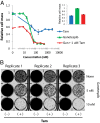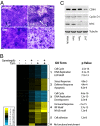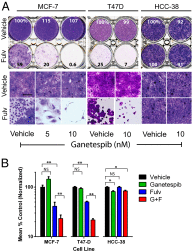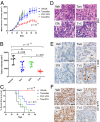HSP90 empowers evolution of resistance to hormonal therapy in human breast cancer models
- PMID: 25489079
- PMCID: PMC4280614
- DOI: 10.1073/pnas.1421323111
HSP90 empowers evolution of resistance to hormonal therapy in human breast cancer models
Abstract
The efficacy of hormonal therapies for advanced estrogen receptor-positive breast cancers is limited by the nearly inevitable development of acquired resistance. Efforts to block the emergence of resistance have met with limited success, largely because the mechanisms underlying it are so varied and complex. Here, we investigate a new strategy aimed at the very processes by which cancers evolve resistance. From yeast to vertebrates, heat shock protein 90 (HSP90) plays a unique role among molecular chaperones by promoting the evolution of heritable new traits. It does so by regulating the folding of a diverse portfolio of metastable client proteins, many of which mediate adaptive responses that allow organisms to adapt and thrive in the face of diverse challenges, including those posed by drugs. Guided by our previous work in pathogenic fungi, in which very modest HSP90 inhibition impairs resistance to mechanistically diverse antifungals, we examined the effect of similarly modest HSP90 inhibition on the emergence of resistance to antiestrogens in breast cancer models. Even though this degree of inhibition fell below the threshold for proteotoxic activation of the heat-shock response and had no overt anticancer activity on its own, it dramatically impaired the emergence of resistance to hormone antagonists both in cell culture and in mice. Our findings strongly support the clinical testing of combined hormone antagonist-low-level HSP90 inhibitor regimens in the treatment of metastatic estrogen receptor-positive breast cancer. At a broader level, they also provide promising proof of principle for a generalizable strategy to combat the pervasive problem of rapidly emerging resistance to molecularly targeted therapeutics.
Keywords: antiestrogen; drug resistance; estrogen receptor; tamoxifen; tumor progression.
Conflict of interest statement
Conflict of interest statement: D.A.P. is an employee of Synta Pharmaceuticals, and M.L.M. holds an equity interest in the company.
Figures




References
-
- Queitsch C, Sangster TA, Lindquist S. Hsp90 as a capacitor of phenotypic variation. Nature. 2002;417(6889):618–624. - PubMed
Publication types
MeSH terms
Substances
Associated data
- Actions
Grants and funding
LinkOut - more resources
Full Text Sources
Other Literature Sources
Medical
Molecular Biology Databases
Miscellaneous

